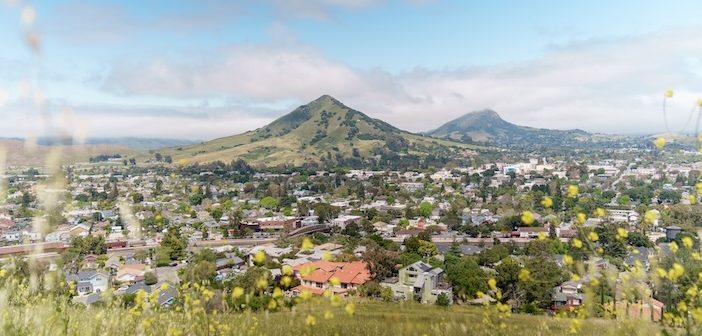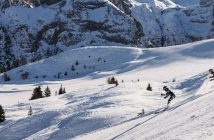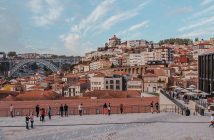In the second part of his tour of the lesser-known parts of Califonia, Larry heads inland, to castles on hilltops and wine-tasting in shipping crates. Among whisper-quiet valleys, and a riotously pink hotel that defies explanation, he discovers the offbeat heart of a California he never knew he needed…
Of course, San Luis Obispo – SLO, to locals – gets its name from its capital city, though far from being a teeming sprawl, it feels more like a small, well-worn novel: compact, charming, and full of character. The downtown is centred around its 18th-century mission and retains the faded elegance of old Californian life, with lovingly preserved facades, the art deco Fremont Theatre, and a smattering of boutiques, cafés and galleries nestled between.
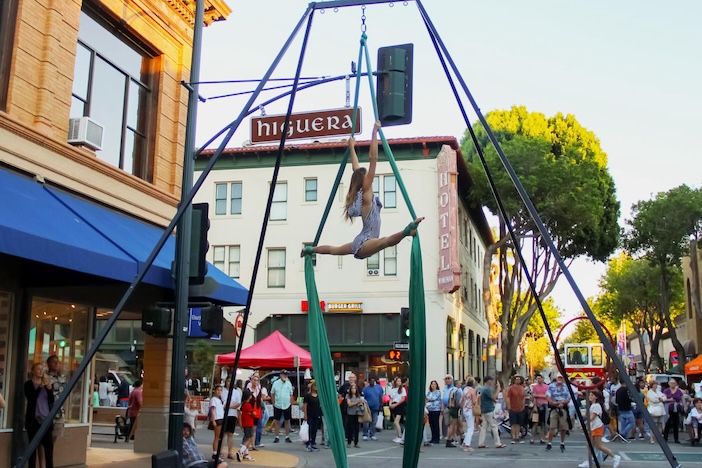
It’s a college town, and as dusk falls the main drag comes to life with students and locals alike. There’s a lively tangle of bars to suit all persuasions, and Frog & Peach – a pub with a patio and a grunge band playing as if stuck in a beautiful 1993 – took me back to misspent years with nostalgic joy. Better yet, every Thursday evening, the town comes alive for a different reason; the Farmers’ Market. Over five blocks, the historic Higuera Street is taken over by some 100 vendors selling everything from crafts to street food and artisanal baked goods all in an atmosphere more reminiscent of carnival, permeated by the enticing smell of barbecue wafting amid the crowds.
Just a block from the mission is Hotel SLO, an emblem of the city’s newfound cool. Its chic, modernist lines and casually sophisticated vibe anchor it firmly in the present, yet the friendliness of the staff and the gentle rhythm of the town give it an easy, unhurried soul.
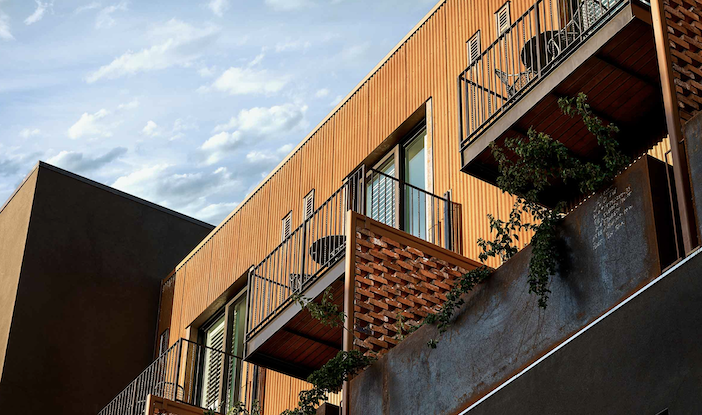
Beyond the city, the inland landscape begins to unfold, soft and sweeping. It’s here that the Hearst Estate rises – or rather, perches – atop the hills like a mirage. Calling it a castle may be a touch theatrical, but there’s no mistaking its opulence. Newspaper magnate William Randolph Hearst’s retreat is pure grandeur; the drive up alone is worth the price of admission. From the summit, the Pacific gleams in the distance, and you half expect to see Gatsby waving from the Greco-Roman pool.
Begun in 1919 – and still unfinished by 1948 – Hearst built it on the site where his parents once brought him camping. The architectural style is an evocative blend of Italian piazzas and Spanish revival, surrounded by imported antiquity and a sense of showmanship worthy of Hollywood – which is just as well, since Hollywood often came calling. Cary Grant, Churchill, Chaplin, GBS – all were guests. Chaplin, when first entering the iconic indoor pool, tiled with millions of Murano glass mosaics, reportedly gave no words, just a whistle.

Hearst set out to create “a museum of the finest things I can acquire,” and by the looks of it, he succeeded. Tapestries here are originals; the ones in the Louvre are copies. The home remains preserved, as though the man himself might return from a ride across the estate – where, incidentally, zebra still roam freely among the oaks.
It’s that mixture of the unexpected and the extraordinary that defines SLO CAL. It surprises. It delights.
For all the surfboards and sand, it’s becoming just as well-known for its wine – the now trending ‘Wine and Waves’ moniker owes much to Paso Robles and, for the oenophile who prefers fewer influencers and more influence, the Edna Valley. Tucked just south of SLO, Edna is the shy cousin to Napa: lesser known, less showy, arguably more sincere. One golden afternoon, I found myself tasting wines at Tolosa Winery, where vineyards planted originally for sacramental purposes at the 1772 Tolosa Mission now yield graceful Chardonnay and Pinot Noir. The Chardonnay, in particular, is a subtle revelation – delicately buttery and refreshingly light.
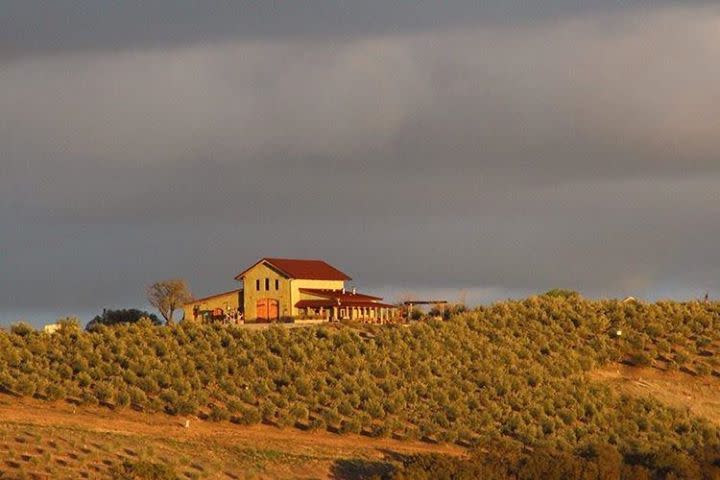
And then, further inland still, the road curves into the hills toward Paso Robles, and the landscape shifts again. The hills here are round and smooth, like the folds of linen left on a sun-lounger. Cypress trees flank winding roads and the architecture takes on a Tuscan familiarity. At Kiler Ridge, I stood among rows of young olive trees – yes, olive trees in California – which seem almost too optimistic for the terrain, but thrive nonetheless. The oil they produce rivals anything I’ve tried in Umbria. It’s both audacious and completely fitting.
Paso’s wineries are, by Californian standards, small – which is why you’ve likely never tasted them outside the region. Most never leave the county. But the quality? Impeccable. At Cass Winery, where the landscape resembles Teletubbyland, the wines are grown on a single estate and the Viognier is, as my host put it, “your tropical holiday in a glass.”
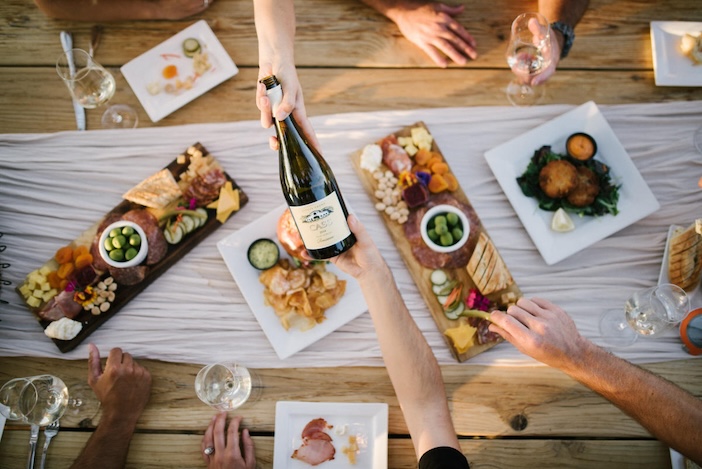
But Cass doesn’t stop there. It’s a winery that innovates. As well as being one of Paso’s only wineries with a restaurant (lunch on the sun-drenched terrace providing the ideal opportunity to sample their offerings), the Cass ‘camp’ offers field trips into the surrounding countryside, and guests can stay in one of a cluster of boutique rooms made entirely from repurposed shipping crates, with the promise of a pool and swim-up wine bar nestled among the vines to come. If that’s not enough to tempt a return visit, I don’t know what is.
Of course, one cannot speak of SLO CAL’s inland identity without mentioning its most eccentric landmark: the Madonna Inn. If Hearst Castle was built to impress, the Madonna Inn was built to bewilder. Candy-pink stucco, rococo flourishes, rooms with names like ‘Caveman’ and ‘Love Nest’, and toilets that belong less in a motel more in a sculpture park, it’s part fever dream, part kitsch masterpiece – and wholly unforgettable. No visit is complete without trying a slice of their flamingo-coloured neon-frosted cake – if only to prove to your eyes that, yes, that colour is edible.

SLO CAL is a place of many Californias. There’s the cowboy wine country of Paso. The bohemian surfer vibes of Pismo. The sun-dappled calm of Avila. It’s a California untouched by cliché, where the road trips feel personal and the discoveries feel earned. The landmarks may not be headliners, but that’s rather the point.
This is California in lowercase – quieter, quirkier, and arguably more real. And in a state so often overrun with expectation, it’s refreshing to find somewhere that simply is.
For more information about SLO CAL, including details of events, festivals and countless things to do, and to start planning your trip, please visit www.slocal.com.
Photos courtesy of Visit SLO CAL

